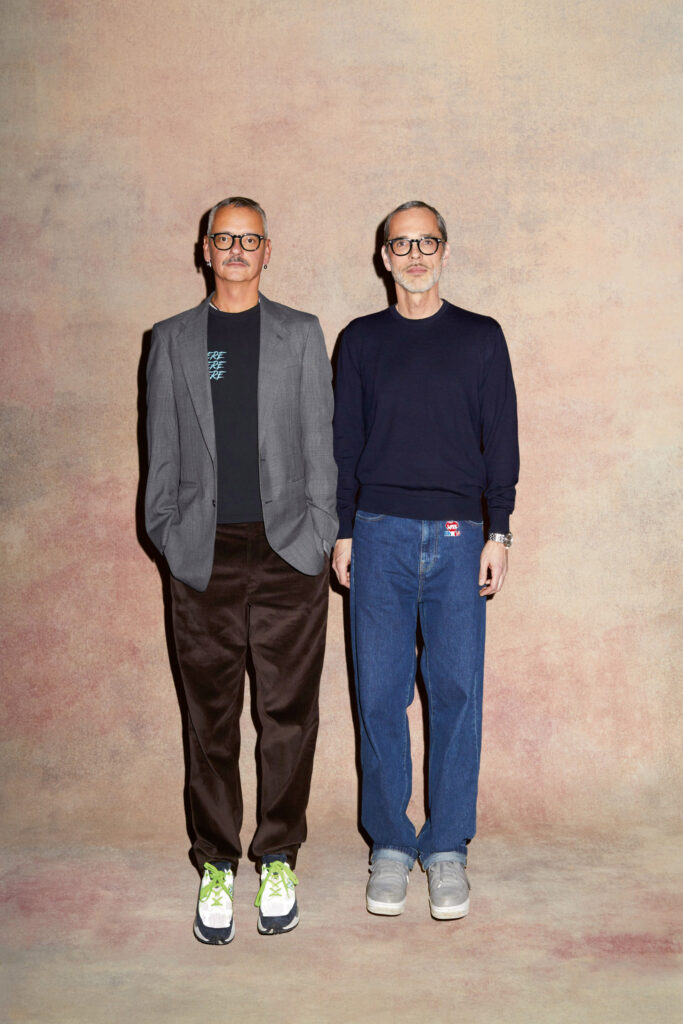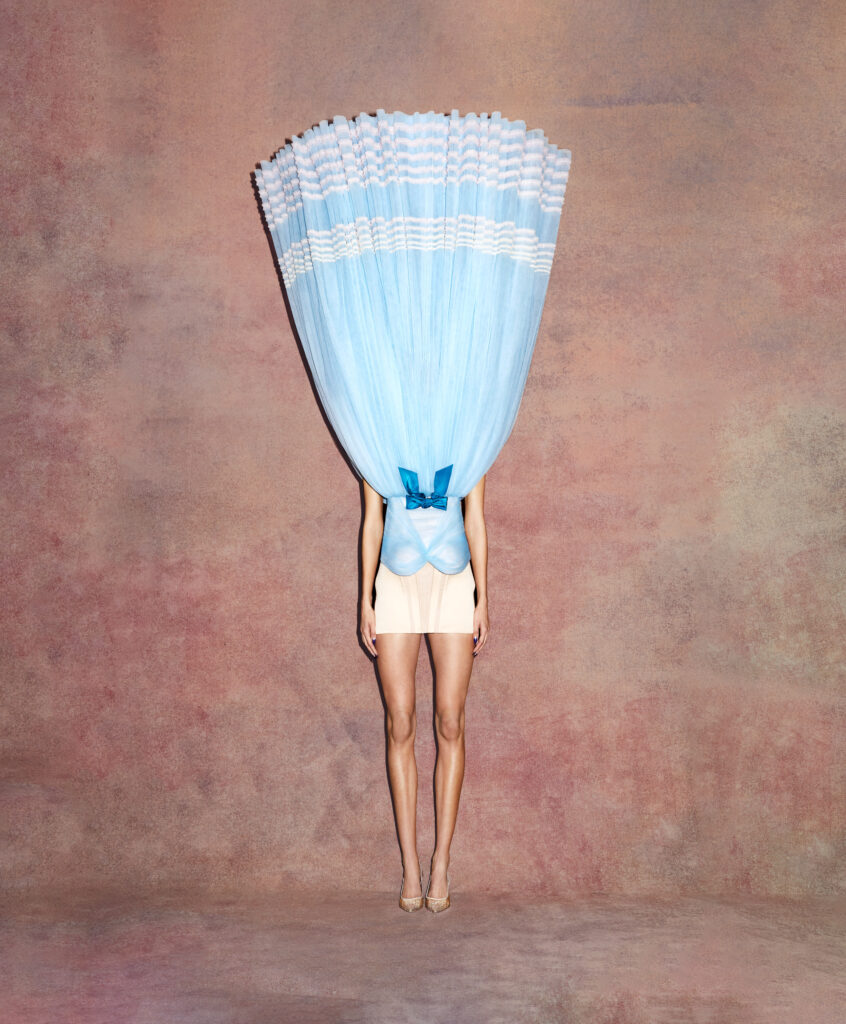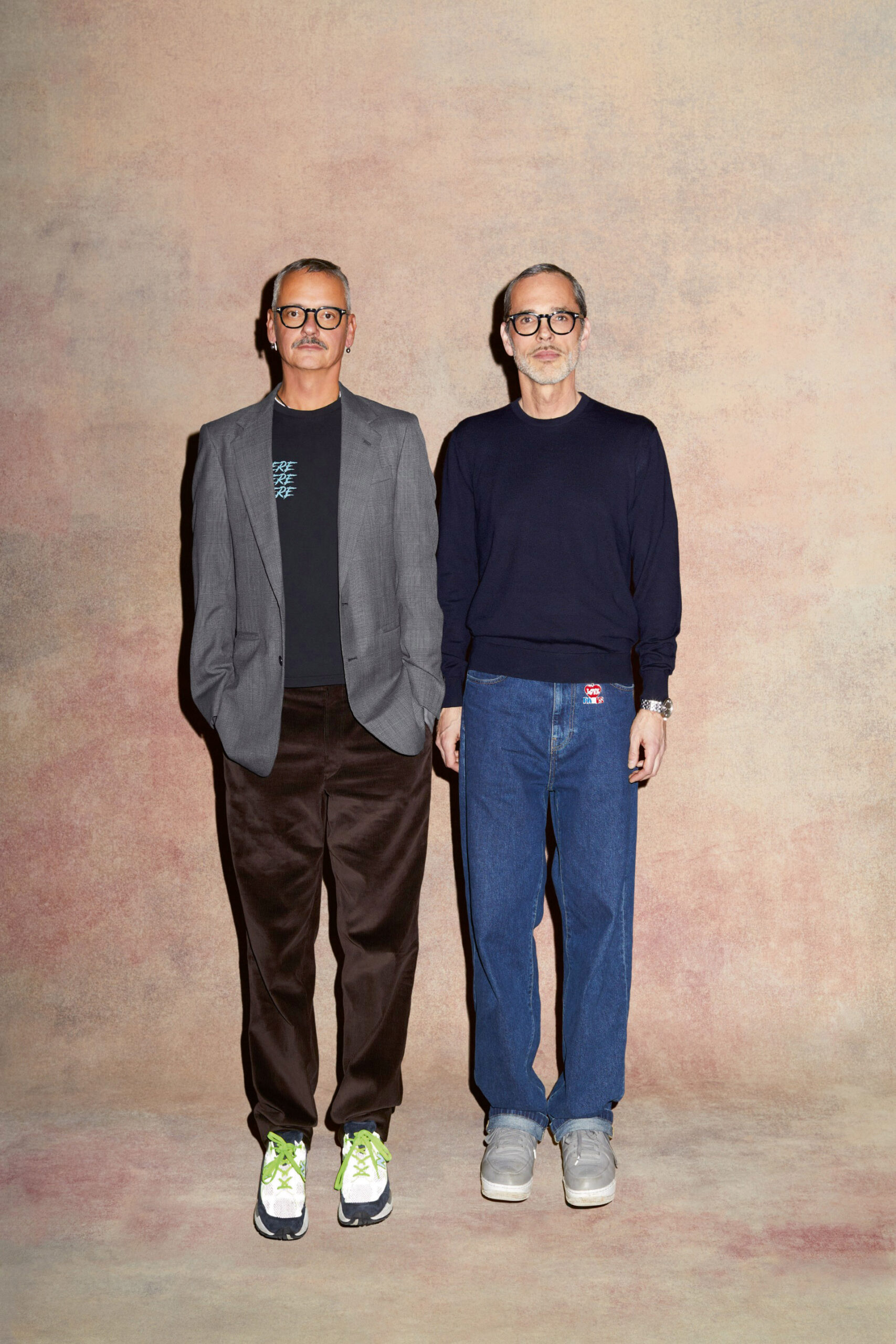For over thirty years, Viktor&Rolf have kept the fine line between art and fashion notoriously blurry. Since first forming the fashion house back in 1993, designers Viktor Horsting and Rolf Snoeren have become next-gen geniuses in their own right, releasing couture creations and buzzed-about runway shows that skillfully bent the rules in the game of what could be versus what should be. “Our shows are usually quite conceptual and have a clear message. Sometimes we even use text in the garments to get the message across,” explain the designers on their approach to delivering a clear narrative. “For example, a collection based around the word ‘NO’, or a collection of romantic tulle evening dresses with quite aggressive slogans on them. A fashion statement, in our case, is not just clothing.”

Photographed by Marijke Aerden. © Marijke Aerden.
This fall, the collective statements released by the designers over the years are now coming together in the first major retrospective of their work. Taking place at the High Museum of Art in Georgia, Viktor&Rolf. Fashion Statements serves as a collision of couture and unbound creativity with more than 100 of the designers’ most avant-garde works. Organized by curator Thierry-Maxime Loriot, the exhibition’s eight “chapters” categorize the wide-spanning work of the duo through carefully curated themes. “We gave [Thierry] carte blanche, as we trust him so much and love his way of curating museum shows. He chose a more thematic approach, analysing our DNA. There is, for example, a ballroom where ball gowns are displayed from many different collections from our 30-plus years, and somehow this works really well. Thierry thought [splitting the exhibition into chapters] was a more engaging way to show our work, less of a purist conceptual approach. It is more like storytelling.”

Photographed by Marijke Aerden. © Marijke Aerden.
But how does one dare to attempt covering over 30 years of work? Selecting which creation from the treasure trove of their archive deserves its time back under a glimmering spotlight? For the duo, the answer is simple. “The choice of all the works was quite easy. Thierry and the two of us were all clear about what to display,” they explain. “Much of our work has been bought by museums all over the world, and not always easy to get for other museum shows as the textile is fragile. But over the years, we have recreated our most iconic looks in miniature for a growing collection of porcelain dolls. We feel these dolls are the best thing we’ve ever done, and we are happy to show them as well in Atlanta.”
With their multi-room experience, both nostalgic and forward feeling, museum-goers will be able to immerse themselves in a Viktor&Rolf wonderland of fashion surrealism, stepping through the duo’s many design eras since the house’s inception. “It made us realize that we have worked with the same themes from the very beginning. As diverse and complex as the work we strive for is, we do seem to get back to basics a lot,” they note. “The first five years of our career, when we lived in Paris, we had hardly any recognition, but it was a very important time for us. [It’s] where we invented our design language and the roots of everything we’ve done.

V MAGAZINE: This is the first major retrospective of your work, recently shown in Germany and now making its way to the US. Could you describe what the beginning stages of creating the exhibition and working with curator Thierry-Maxime Loriot were like? Did you both go in knowing exactly how you wanted to create the structure of the exhibition?
VIKTOR & ROLF: It was a great pleasure to work with Thierry [Maxime Loriot]. We have known each other for many years and have worked together on exhibitions in Australia and Europe. This time, we gave him carte blanche, as we trust him so much and love his way of curating museum shows. He chose a more thematic approach, analysing our DNA. There is, for example, a ballroom where ball gowns are displayed from many different collections from our 30+ years, and somehow this works really well. Thierry thought [splitting the exhibition into chapters] was a more engaging way to show our work, less of a purist conceptual approach. It works really well; it’s more like storytelling.
V: How does one approach covering over 30 years of work? What did the curation process look like when selecting which looks/pieces you felt had a place within the exhibition?
V&R: A lot of pieces on display come from our own storage. Much of our work has been bought by museums all over the world, and not always easy to get for other museum shows as the textile is fragile. But over the years, we have recreated our most iconic looks in miniature for a growing collection of porcelain dolls. We feel these dolls are the best thing we’ve ever done, and we are happy to show them as well in Atlanta. The choice of all the works was quite easy. Thierry and the two of us were all clear about what to display.
V: The exhibition itself is called Fashion Statements. How did you come to the conclusion that this title sums up what you’re showing the world?
V&R: Our shows are usually quite conceptual and have a clear message. Sometimes we even use text in the garments to get the message across. For example, a collection based around the word “NO”, or a collection of romantic tulle evening dresses with quite aggressive slogans on them. A fashion statement, in our case, is not just clothing.
V: An interesting element of the exhibition is the use of the “works-in-progress” dolls. Where did the fascination with antique dolls stem from? What do you find intriguing when working on the dolls and creating those miniature looks for them?
V&R: We started making them for an exhibition at the Barbican in London. We loved the idea of recreating our contemporary fashion on Victorian dolls, making our work look historical right away. A timeless sensation for fashion that in itself is so ephemeral. These porcelain dolls are not sweet; they have a real presence. They are not so small, about 70 centimeters tall. The makeup is baked in the style of the show, and the human hair wigs are styled in the style of the show.
V: Like any exhibition, there’s going to be a wide range of museum goers that will soon view the work and, in particular, there’s bound to be fashion students in attendance. What do you hope those young creatives can take away from viewing the retrospective and seeing your design evolution?
V&R: We love to showcase our work in museums, as the fashion world is so elitist and so few people can see the shows. A museum is democratic, and most of all, the incredible craftsmanship can be seen and analysed. As well, the three-dimensional architectural quality is on display, as most of the work is only known as a catwalk photo.
V: Having first started out using vintage fabrics and establishing your signature motifs early on when creating your first few pieces, how did it feel revisiting your earlier work and placing it alongside your more recent work? Did seeing that evolution strike a chord with you?
V&R: Yes, very much so. It made us realise that we have worked with the same themes from the very beginning. As diverse and complex as the work we strive for is, we do seem to get back to basics a lot. The first five years of our career, when we lived in Paris, we had hardly any recognition, but it was a very important time for us, where we invented our design language and the roots of everything we’ve done.
This story appears in the pages of V155: now available for purchase!
Discover More




